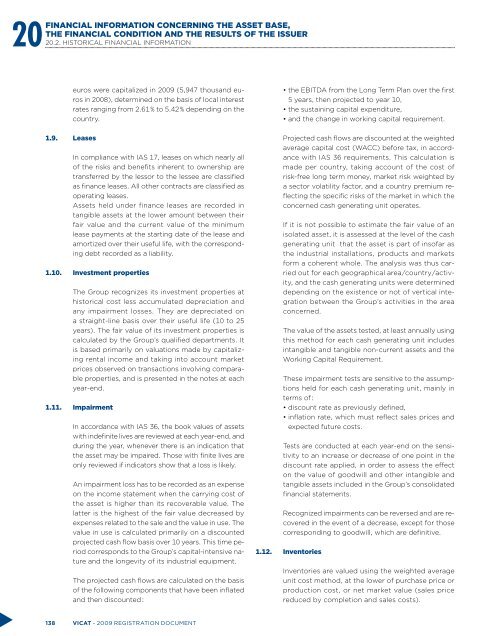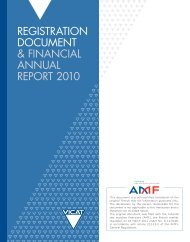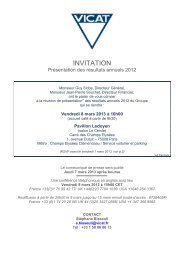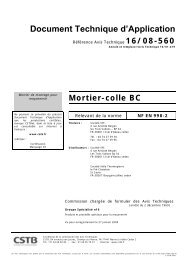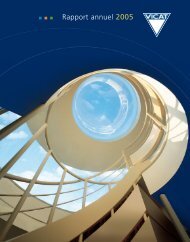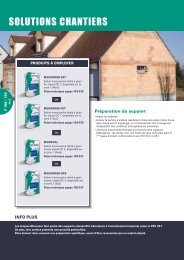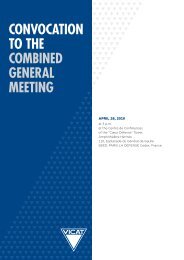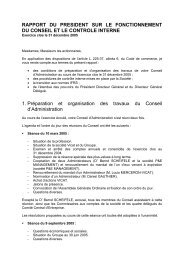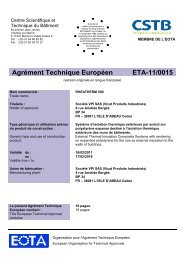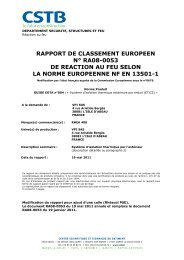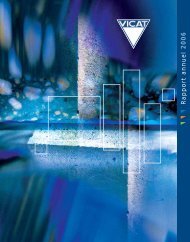6 - Vicat
6 - Vicat
6 - Vicat
- No tags were found...
Create successful ePaper yourself
Turn your PDF publications into a flip-book with our unique Google optimized e-Paper software.
20Financial information concerning the asset base,the financial condition and the results of the issuer20.2. HISTORICAL FINANCIAL INFORMATION1.9. Leaseseuros were capitalized in 2009 (5,947 thousand eurosin 2008), determined on the basis of local interestrates ranging from 2.61 % to 5.42 % depending on thecountry.In compliance with IAS 17, leases on which nearly allof the risks and benefits inherent to ownership aretransferred by the lessor to the lessee are classifiedas finance leases. All other contracts are classified asoperating leases.Assets held under finance leases are recorded intangible assets at the lower amount between theirfair value and the current value of the minimumlease payments at the starting date of the lease andamortized over their useful life, with the correspondingdebt recorded as a liability.1.10. Investment propertiesThe Group recognizes its investment properties athistorical cost less accumulated depreciation andany impairment losses. They are depreciated ona straight-line basis over their useful life (10 to 25years). The fair value of its investment properties iscalculated by the Group’s qualified departments. Itis based primarily on valuations made by capitalizingrental income and taking into account marketprices observed on transactions involving comparableproperties, and is presented in the notes at eachyear-end.1.11. ImpairmentIn accordance with IAS 36, the book values of assetswith indefinite lives are reviewed at each year-end, andduring the year, whenever there is an indication thatthe asset may be impaired. Those with finite lives areonly reviewed if indicators show that a loss is likely.An impairment loss has to be recorded as an expenseon the income statement when the carrying cost ofthe asset is higher than its recoverable value. Thelatter is the highest of the fair value decreased byexpenses related to the sale and the value in use. Thevalue in use is calculated primarily on a discountedprojected cash flow basis over 10 years. This time periodcorresponds to the Group’s capital-intensive natureand the longevity of its industrial equipment.The projected cash flows are calculated on the basisof the following components that have been inflatedand then discounted :• the EBITDA from the Long Term Plan over the first5 years, then projected to year 10,• the sustaining capital expenditure,• and the change in working capital requirement.Projected cash flows are discounted at the weightedaverage capital cost (WACC) before tax, in accordancewith IAS 36 requirements. This calculation ismade per country, taking account of the cost ofrisk-free long term money, market risk weighted bya sector volatility factor, and a country premium reflectingthe specific risks of the market in which theconcerned cash generating unit operates.If it is not possible to estimate the fair value of anisolated asset, it is assessed at the level of the cashgenerating unit that the asset is part of insofar asthe industrial installations, products and marketsform a coherent whole. The analysis was thus carriedout for each geographical area/country/activity,and the cash generating units were determineddepending on the existence or not of vertical integrationbetween the Group’s activities in the areaconcerned.The value of the assets tested, at least annually usingthis method for each cash generating unit includesintangible and tangible non-current assets and theWorking Capital Requirement.These impairment tests are sensitive to the assumptionsheld for each cash generating unit, mainly interms of :• discount rate as previously defined,• inflation rate, which must reflect sales prices andexpected future costs.Tests are conducted at each year-end on the sensitivityto an increase or decrease of one point in thediscount rate applied, in order to assess the effecton the value of goodwill and other intangible andtangible assets included in the Group’s consolidatedfinancial statements.Recognized impairments can be reversed and are recoveredin the event of a decrease, except for thosecorresponding to goodwill, which are definitive.1.12. InventoriesInventories are valued using the weighted averageunit cost method, at the lower of purchase price orproduction cost, or net market value (sales pricereduced by completion and sales costs).138 VICAT - 2009 registration document


